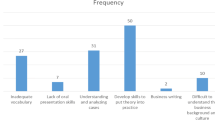Abstract
In this study, we aimed to understand experience of students about transition from lecture mode to case study pedagogy in business management courses. Indian education system is predominantly a follower of the lecture mode of teaching from the grass-root level till graduation. Hence Indian students are relatively less familiar with the case based teaching method. In recent times, the case pedagogy has been rapidly replacing the lecture mode in higher education institutes of India, especially at the business management colleges. We conducted a grounded theory based interview of 33 post graduate students enrolled in a business school (B School) in India, which incorporated a pedagogy shift from lecture to case method during academic session 2010–2011. We found that some of the major factors which facilitated the transition process of the students to this new style of learning were previous educational background, prior work experience, course evaluation methods, institute policies and proper orientation through preparatory sessions. Our findings substantiated extant studies conducted in the context of western countries. The findings also provide a systematic analysis of the various issues in incorporating such pedagogic shifts, which may help academicians to successfully troubleshoot any problems associated with commencement of case based teaching in the Indian context.




Similar content being viewed by others
References
Antill, L. (2007). Towards active case based learning in IS. International Journal of Teaching and Case Studies, 1, 146–158.
Argyris, C. (1980). Some limitations of the case method: Experiences in a management development program. Academy of Management Review, 5, 291–298.
Boddy, C. R. (2004). From brand image research to teaching assessment: Using a projective technique borrowed from marketing research to aid an understanding of teaching effectiveness. Quality Assurance in Education, 12, 94–105.
Boddy, C. R. (2007). Projective techniques in Taiwan and Asia-Pacific market research. Qualitative Market Research, 10, 48–62.
Carlson, W. L. (1999). A case method for teaching statistics. Journal of Economic Education, 30, 52–58.
Carroll, J. M., & Borge, M. (2007). Articulating case-based learning outcomes and assessment. International Journal of Teaching and Case Studies, 1, 33–49.
Chang, J., Kwan-Ling, N., Karen, K. L. M., Bosco, Y., & Lai-kuen, C. (2005). Students’ view on the use of case method in China. Developments in Business Simulation and Experiential Learning, 32, 85–90.
Corbin, J., & Strauss, A. (1990). Grounded theory research: Procedures, canons, and evaluative criteria. Qualitative Sociology, 13, 3–21.
Desiraju, R., & Gopinath, C. (2001). Encouraging participation in case discussions: A comparison of the MICA and the Harvard case methods. Journal of Management Education, 25, 394–408.
Dixit, M. R., Manikutty, S., Rao, S. S., Monippally, M. M., Bijapurkar, R., Raghuram, G., et al. (2005). What is the future of the case method in management education in India? Vikalpa, 30, 87–131.
Dowd, J. J., Jr. (1992). Case method teaching: Suggestions for practice. Marketing Education Review, 2, 44–48.
Fisher, C. F. (Eds.) (1978). Being there vicariously by case studies. In On college teaching. San Francisco, Jossey-Bass: Ohmer Milton.
Golafshani, N. (2003). Understanding reliability and validity in qualitative research. The Qualitative Report, 8, 597–607.
Goulding, C. (2000). Grounded theory methodology and consumer behavior, procedures, practice and pitfalls. Advances in Consumer Research, 27, 261–266.
Harling, K. F., & Akridge, J. (1998). Using the case method of teaching. Agribusiness, 14, 1–14.
Hawes, J. M. (2004). Teaching is not telling: The case method as a form of interactive learning. Journal of Advanced Marketing Issues, 5, 47–54.
Jick, T. D. (1979). Mixing qualitative and quantitative methods: Triangulation in action. Administrative Science Quarterly, 24, 602–611.
Lombard, M., Snyder-Dutch, J., & Bracken, C. C. (2002). Content analysis in mass communication: Assessment and reporting of inter-coder reliability. Human Communication Research, 28, 587–604.
Pearce, R. J. (2002). Case based structured conflict—a means for enhancing classroom learning. Journal of Management Education, 26, 732–744.
Pointer, L. G., & Ljungdahl, P. W. (1973, July). The merit of using the case method in teaching the specialized accounting course, The Accounting Review, 614–618.
Rodon, J., & Pastor, J. A. (2007). Applying grounded theory to study the implementation of an inter-organizational information system. The Electronic Journal of Business Research Methods, 5, 71–82.
Author information
Authors and Affiliations
Corresponding author
Rights and permissions
About this article
Cite this article
Roy, S., Banerjee, P. Understanding students’ experience of transition from lecture mode to case-based teaching in a management school in India. J Educ Change 13, 487–509 (2012). https://doi.org/10.1007/s10833-012-9191-4
Published:
Issue Date:
DOI: https://doi.org/10.1007/s10833-012-9191-4




